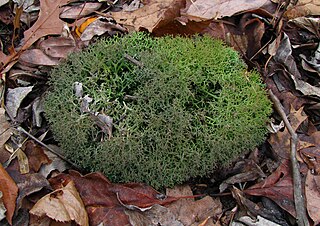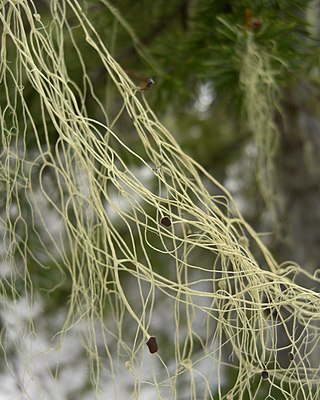
Vulpinic acid is a natural product first found in and important in the symbiosis underlying the biology of lichens. It is a simple methyl ester derivative of its parent compound, pulvinic acid, and a close relative of pulvinone, both of which derive from aromatic amino acids such as phenylalanine via secondary metabolism. The roles of vulpinic acid are not fully established, but may include properties that make it an antifeedant for herbivores. The compound is relatively toxic to mammals.

Lobaria pulmonaria is a large epiphytic lichen consisting of an ascomycete fungus and a green algal partner living together in a symbiotic relationship with a cyanobacterium—a symbiosis involving members of three kingdoms of organisms. Commonly known by various names like tree lungwort, lung lichen, lung moss, lungwort lichen, oak lungs or oak lungwort, it is sensitive to air pollution and is also harmed by habitat loss and changes in forestry practices. Its population has declined across Europe and L. pulmonaria is considered endangered in many lowland areas. The species has a history of use in herbal medicines, and recent research has corroborated some medicinal properties of lichen extracts.

Letharia vulpina, commonly known as the wolf lichen, is a fruticose lichenized species of fungus in the family Parmeliaceae. It is bright yellow-green, shrubby and highly branched, and grows on the bark of living and dead conifers in parts of western and continental Europe and the Pacific Northwest and northern Rocky Mountains of North America. This species is somewhat toxic to mammals due to the yellow pigment vulpinic acid, and has been used historically as a poison for wolves and foxes. It has also been used traditionally by many native North American ethnic groups as a pigment source for dyes and paints.

Xanthoparmelia chlorochroa, known as the tumbleweed shield lichen or ground lichen, is a foliose lichen in the Parmeliaceae family. It is not fixed to a substrate, and blows around in the wind from location to location.

Cladonia furcata or the many-forked cup lichen is a species of cup lichen in the family Cladoniaceae. It has an intermediate to tolerant air pollution sensitivity. Extracts of this species have been shown to kill leukemia cells in vitro, and may have possible value in the treatment of cancer.

Vulpicida is a genus of lichenized fungi in the family Parmeliaceae. Circumscribed in 1993 to contain species formerly placed in Cetraria, the genus is widespread in Arctic to northern temperate regions, and contains six species. The genus is characterized by the presence of the secondary metabolites pulvinic acid and vulpinic acid, compounds that when combined with usnic acid, give the species their characteristic yellow and green colors.

Nephroma is a genus of medium to large foliose lichens. The genus has a widespread distribution. They are sometimes called kidney lichens, named after the characteristic kidney-shaped apothecia that they produce on the lower surface of their lobe tips, which often curl upwards and thus are visible from above. Sterile specimens that do not have apothecia can look somewhat like Melanelia, Peltigera, Platismatia, or Asahinea. Most species grow either on mossy ground or rocks, or on trees.

Menegazzia terebrata is a species of foliose lichen found scattered across many continents, including North America, South America, Europe, Africa, and Asia.

Phacopsis is a genus of lichenicolous (lichen-dwelling) fungi. They are parasites of members of the large lichen family Parmeliaceae, of which they are also a member. Originally proposed by Edmond Tulasne in 1852 to contain 3 species, Phacopsis now contains 10 species, although historically, 33 taxa have been described in the genus. Many of the species are poorly known, some of them having been documented only from the type specimen.

Pilophorus acicularis, commonly known as the nail lichen or the devil's matchstick lichen, is a species of matchstick lichen in the family Cladoniaceae.
Lichens of the Sierra Nevada have been little studied. A lichen is a composite organism consisting of a fungus and a photosynthetic partner growing together in a symbiotic relationship.

Alectoria sarmentosa is a long-lived, perennial witch's-hair lichen. It is a light greenish colored and fruticose or bushy bodied. This epiphytic lichen belongs to the family Parmeliaceae and the suborder Lecanorineae, which includes six similar species. A. sarmentosa grows draped or strung over conifer tree limbs and deciduous shrub branches in Northern temperate rainforest. This lichen favors mature and old growth, wet conifer and hardwood forests with clean air. A. sarmentosa is sensitive to air pollution and used for air quality monitoring. Areas required by A. sarmentosa are found in northern and southern temperate zones and receive high rainfall. This lichen is commonly found in transitional areas between valley and mountainous forests, but usually avoiding the immediate coast.

In lichens, rhizines are multicellular root-like structures arising mainly from the lower surface. A lichen with rhizines is termed rhizinate, while a lichen lacking rhizines is termed erhizinate. Rhizines serve only to anchor the lichen to their substrate; they do not absorb nutrients, as do plant roots. Characteristics of the rhizines are used to identify lichens, for example, whether they are dense or sparse, uniformly distributed or clumped in specific areas, and straight or branched. Only foliose lichens may possess rhizines, not crustose or fruticose lichens, which lack a lower cortex.

Punctelia rudecta, commonly known as the rough speckled shield or the speckleback lichen, is a North American species of foliose lichen in the family Parmeliaceae. This species can be readily identified by the light color of the thallus underside, the relatively large lobes at the edges of the thallus, and the tiny white pores present on the top of the thallus that are characteristic of the genus Punctelia. The lichen is quite abundant and widespread in the eastern and southeastern United States, although it also occurs in Canada and northern Mexico, but is less common in these regions. The lichen usually grows on bark, and less commonly on shaded rocks. There are several lookalike Punctelia species; these can often be distinguished from P. rudecta by differences in distribution or in the nature of the reproductive structures present on the thallus.

Hypogymnia krogiae, commonly known as the freckled tube lichen, is a species of foliose lichen in the family Parmeliaceae. Found in North America, it was described as a new species in 1973 by Karl Ohlsson. The type specimen was collected near Cheat Bridge, West Virginia by Mason Hale in 1956.

Candelaria concolor, commonly known as the candleflame lichen or the lemon lichen, is an ascomycete of the genus Candelaria. It is a small foliose lichen dispersed globally.
Megalospora austropacifica is a species of corticolous (bark-dwelling), crustose lichen in the family Megalosporaceae. It is found on the islands of Taveuni and Viti Levu in Fiji. It has a yellowish grey to whitish grey, glossy thallus that is thick and may appear slightly wrinkled or smooth, often with irregular cracks and small papillae containing conidiomata, but lacking isidia and soredia. Its apothecia are circular, up to 4.5 mm in diameter, with the disc evolving from concave to slightly convex and coloured from orange-brown to red-brown, surrounded by a thick, prominent margin.

Baeomyces heteromorphus is a species of terricolous (ground-dwelling) lichen in the family Baeomycetaceae. It has an Australasian distribution. Characteristics of the lichen include its greenish-grey thallus, the pink to brownish discs of its apothecia, translucent spores lacking internal partitions (septa), and the presence of the secondary metabolites norstictic acid and connorstictic acid.
Buellia bahiana is a crustose-type lichen species that frequently grows on the bark and wood of trees found in coastal and inland forest habitats. This lichen species exhibits a broad geographic distribution, being documented in various pantropical and subtropical regions around the world. Specific areas where Buellia bahiana has been recorded include parts of Australia, Africa, North America, Central America, South America, and several Pacific Island chains.


















